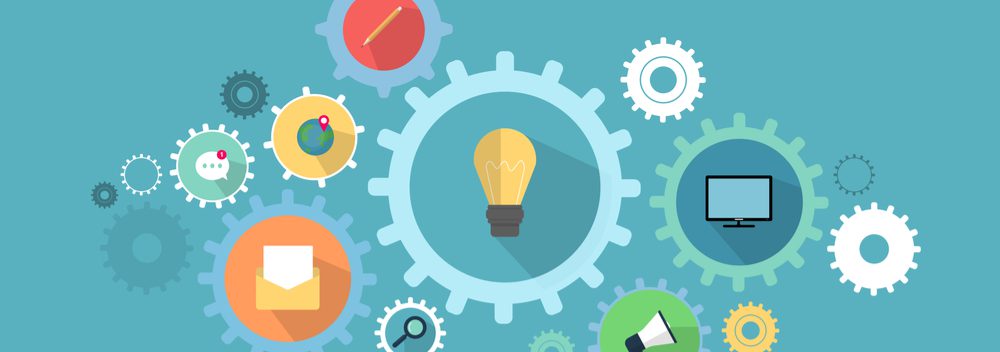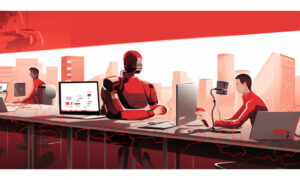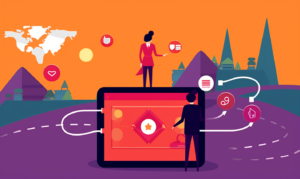The biggest trends in HR technology and software
- 10 Min Read
What are the biggest trends in HR Technology in 2019, and what do they mean for business success in the near future?
- Author: HRD Connect
- Date published: Aug 14, 2019
- Categories

Technology has made HR more strategic than ever before. The latest HR Technology trends – AI, machine learning, people analytics, and more – are setting the stage set for HR to become more than just a part of digital transformation. Instead, a tech-powered HR function will lead digital transformation in their organisation.
From sourcing, selecting and hiring talent, to organizational design, networking, and employee experience, HR Technology has spread across every aspect of HR function to benefit every aspect of business.
In 2019’s Global Human Capital Trends survey, 74% of respondents rated HR technology to be either important or very important, while 21% rated it one of the three most urgent topics their organizations currently face.
According to a survey by Gartner, by 2020, 30% of global midmarket and large enterprises will have invested in a cloud-deployed human capital management (HCM) suite for administrative HR and talent management, but will still need to source 20-30% of their HR requirements through other vendors.
Artificial Intelligence (AI), Robotics, Virtual Reality (VR), Augmented reality (AR), MR (mixed reality) and other kinds of HR Technology are paving the way for stronger business continuity and company operations. Other people HR Technology trends, in fields like recruiting & selection, learning & developing (L&D) and employee engagement, are enhancing employee experience throughout organisations.
So, what are the biggest trends in HR Technology in 2019?
Big Data & Data Analytics
A survey by Deloitte states that, “The use of workforce data to analyze, predict, and improve performance has exploded in practice and importance over the last few years, with more growth on the horizon.”
Big data and analytics will play an essential role in the growth of employees and organizations. Presently, to understand the growth of a company, centralized HRMS data is run through several analytical tools. With big data and data analytics, HR professionals can ensure compliance and avoid risk.
Behavior Analysis
The sophistication of AI tools has grown considerably in recent years. AI tools are now able to recognize facial expressions and voice inflections, which could be of particular use during job interviews. In this context, AI tools analyse a job seeker’s behaviour to determine whether they are the best candidate for the role.
AI & ML
Artificial Intelligence and Machine Learning tools are designed to streamline the internal functions of a company, thereby improving their operations. The use of AI is expected to improve employee experience, while efficiently managing the employee lifecycle. In 2019, we’re likely to witness further advancement in chatbots, assistance and ESS portals. A study conducted by EY concluded that AI has strong potential to improve employee productivity and help HR professional to boost employee performance.
Employer Branding and Recruitment Market
Employer branding is an increasingly important part of talent attraction and retention. Organizations must create strong employer branding strategies and execute them effectively to ensure they’re attracting the right people. For example, Heineken created a series of unconventional web interviews to highlight their employee experience, which helped them set their company apart and attract high-level candidates.
Using Smart HRMS tools allows HR professionals to automate candidate interactions and, through an Applicant Tracking System (ATS), allow them to schedule recruitment processes with greater efficiency.
Videos for Hiring
The job market is highly competitive, meaning HR professionals must try to find new, creative ways of finding the right candidates – visual storytelling being one such method of doing so. Video addresses this challenge by promising a more captivating candidate experience.
A study by CareerBuilder found that if a job advertisement is posted with a video, it is viewed 12% more than a written advertisement, while the number of applicants number increases by 34%.
Intelligent Self-Service Tool
In 2019, automated self-service is expected to reduce dependency on HR for everyday tasks, such as holiday management, annual leave, and attendance. As a result, self-service tools will increase employee productivity by giving them the ability to manage their tasks, and will give the HR function greater capacity to focus on broader issues.
Furthermore, intelligent self-service tools will improve the internal and external stakeholders experience, which is the core business objective of any organization. Intelligent self-service solutions comprise several different technologies, including chatbots, online communities, apps, and more.
Leveraging new technologies has proved beneficial for many companies, such as Facebook and Google. However, the HR Technology you choose depends on the needs of your organisation and how you want to grow.
Different aspects of the HR function require different technologies.
Recruitment
Use of AI: According to a study by Undercover Recruiter in 2018, AI is expected to replace 16% of HR jobs within the next 10 years.
AI powered products and services like Gloat, Beamery, Textio, Paradox, Restless Bandit, Paññã, TextRecruit, Woo, RampUp, Mya Systems, Hiretual, Entelo, ARYA, XOR and Wade & Wendy are killing the myth that AI is applicable only to big ideas like automated cars and humanoid robots.
Innovation in recruitment continues to thrive, and more and more AI-driven solutions for recruitment challenges problems are emerging.
Social recruitment: Social recruiting, social hiring or social media recruitment refers to the process of recruiting candidates by using social platforms as talent databases or for advertising. Social recruitment is one of an important upcoming HR Technology trends in recruitment.
The increasing use of social media among millennials has compelled recruiters to become more active on social platforms, to simultaneously communicate with potential candidates and engage their current employees.
Social recruiting uses social media profiles, blogs, and other websites to find information on candidates and share job details.
Using Blockchain: Blockchain, a technology that first made waves in the finance industry, has given rise to a new business model that is built on technology, rather than reliance on people as intermediaries. This is exactly what makes blockchain a valuable tool for the recruitment industry. While most blockchain applications for recruitment are still in the theoretical stage, it’s potential cannot be ignored.
Despite the fact that recruitment usages of blockchain are still in a nascent stage, companies have already begun exploring its various possibilities. Here are three ways blockchain could transform recruiting
- Credential Verification
- Employment histories
- Data Security
A candidate could have all their personal information – prior addresses, previous employers, past compensation data, certifications, degrees, transcripts, Social Security number, visa status – pre-validated and stored on a secure blockchain application.
Blockchain is certainly more than just Bitcoin or cryptocurrency, and it will play a central role in the hiring process in the near future.
Data Analytics: Predictive Analytics tools have recently become a major trend in HR Technology. Predictive analytics, at the disposal of the recruiters and head-hunters, will not only help in improving recruitment processes but also ensure quality talent acquisition.
Learning and Development
Companies place a great deal of importance on learning and development, yet, according to a study by Rallyware, covering 14 industries across North America and Europe, 78% of training leaders are not satisfied with the solutions they currently have and are in the process of adding modifications to their learning technologies.
AR and VR: Augmented reality and virtual reality are widely believed to be solely used in gaming, but these technologies will have a larger, lasting impact on learning and development. A 2018 Capterra survey on top tech trends found as many as 46% of small and medium-sized businesses are looking into leveraging VR as an L&D tool in the next two years.
According to Deloitte, VR is a method of training that can break ‘trade-off’ of learning – that it is time-consuming and expensive with limited results – and provide practical training in a safe and cost-effective environment. As one of the HR Trends 2019, corporates will utilize the AR-VR training method and apply it for a better understanding of the employees.
AI and ML: Artificial intelligence and machine learning stand to make a significant impact on how we learn in the workplace, especially when it comes to personalisation and measuring effectiveness. IBM recently noted that, by introducing AI into a workplace, employees can receive more personalized recommendations to facilitate evergreen, curated learning paths and anticipatory career management.
Automation and ChatBots: Automation and ChatBots have the potential to vastly improve learning and development in organisations by expediting processes and anticipating employee needs. Companies embracing automation need to work closely with L&D to teach employees how to work alongside these new tools. Bots will become vehicles to quickly place training in front of employees, placing their own development at their fingertips.
Compensation and Benefits
A company’s culture and its compensation and benefits system must be properly balanced to achieve their strategic goals. Companies need to make sure that these aspects are aligned. Compensation and benefits are business activities with constantly moving parts, the manual management of which wastes a great deal of time.
HR Technology trends are shaping employees’ views and outlook towards compensation and benefits. Facilities like online employee benefits portals, virtual healthcare and behaviour enhancing apps are leading employees to expect a consumer-grade experience in the workplace.
Performance Appraisal
Performance appraisal is an important aspect of an employee’s career development; hence companies are taking emerging technology trends in this space seriously.
As one of the foremost HR Trends of 2019, big data and analytics will be an important part of the progression of both employees and their organisations. Currently, to understand the growth of a company, centralized HRMS data is run through several analytical tools. With big data and data analytics, HR professionals can ensure compliance and avoid risk.
Technology-enabled performance management is a far more comprehensive and holistic solution than traditional methods of performance management. Performance management technology is focused on maximizing people development, improving the performance of individuals and the entire organization. Digital tools, technologies and intelligent machines can transform people development, enabling supervisors to trace contributions from individuals and teams with more accuracy and solid data.
Advanced technologies can also be used to design performance development initiatives. Consider Bank of America, which had its call centre workers wear sensor-enabled ID badges to track locations, tone of voice, body language and communication patterns. Call centre leaders were surprised to discover that workers who took breaks at the same time as others were happier and completed calls 23% faster than workers who took breaks in staggered shifts. Thus, a simple change in mandatory break times led to a 75% reduction in the call centre’s burn rate and approximately US $15 million annual savings.
Diversity and Inclusion
Diversity and inclusion in the workplace has been a focal point for HR and employer branding strategies for quite some time now, and there are numerous HR Technology trends driving increased attention on diversity and inclusion.
Diversity and inclusion technology is enterprise software that provides insights or alters processes or practices, at the individual or organizational level, in support of organizations’ efforts towards introducing and enhancing diversity and inclusion in the workplace.
The most obvious potential benefit of diversity and employee inclusion technology is the opportunity to create consistent, scalable practices that can identify or mitigate biases across organizations, often in real-time. This is the fundamental rationale behind having diversity and inclusion in the workplace.
Diversity and inclusion technology is targeted at either candidates or employees. Additionally, there is diversity and inclusion analytics, which is used for monitoring, including pay equity analysis, employee resource group (ERG) management and analysis, and diversity and inclusion business case analysis.
You can find out more about diversity and inclusion technology by reading the Diversity & Inclusion Technology: The Rise of a Transformative Market report by Stacia Sherman Garr, RedThread Research, in partnership with Carole Jackson, Mercer.
As per McKinsey & Company’s latest report on racial diversity and company financial performance, executive teams ranking in the top 25 percent for racial and ethnic diversity were 33% more likely to reap financial returns above the national median for their industries.









